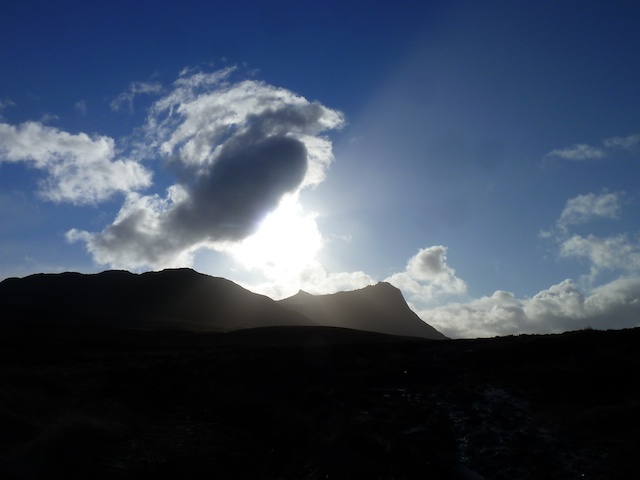Getting pumped and scared at the lip of the roof on Castle in the Sky, Druim Shionnach. Photos: Andy Turner.
A few weeks ago I mentioned I’d tried a huge roof in winter. It was up on Druim Shionnach on the Skye Road, about half an hour from my house. Things didn’t go very well with that. I tried it maybe three times and on my last try ripped out a tiny chockstone in the thin crack in the roof that was crucial for the crux lunge in the middle of the roof. After that it was a parallel crack and neither myself, Donald or Michael could work out how this section could go. So for now at least (I never say never), I was a bit stumped.
But at the end of the day I had a brief foray on the roof just to it’s left. About 5 metres straight across the smooth horizontal roof with no crack system to follow. I tried to aid across it just to see if there could be any hooks at all. It looked like an outside chance of being possible but at a silly grade.
I had another session to aid around the lip and see if it might be possible. Just aiding was scary enough. I was forced to aid mostly on my axes on tiny hooks as there was very little gear in the roof or around the lip. In the end all the protection after the first metre in the roof was one poor downpointing blade and one pecker on the headwall. I was pretty sure a fall would strip them both and would mean a long fall and big smash into the lower wall. But at least I found some hooks and could see that it might go with 2 figure-four moves in a row across the roof. There would be nothing for it but to have an all out go for it and make sure I didn’t fall off onto that gear!

Andy Turner and Ruth Taylor came up with me and Andy abseiled down to take some pictures and provide some much needed encouragement. The VII wall below the roof was the perfect warm up and I arranged the little cams at the start of the roof, changed gloves and got nervous. Eventually there was nothing for it so spanned out from the undercut hook at the back and launched out. Cutting loose onto the first hook, I swung out to see it wasn’t in the hook at all and hanging off a microscopic nubbin. As I dangled wondering what to do I explained to Ruth in a heated manner that I was about to lose my only point of contact with the roof. Rather than try and get a figure four in, which would surely rip with a head first fall, I attempted the start of a one armer and got as far as pulling my shoulder in a bit!
That was enough to just reach into the next undercut hook and I was back in business. All this rather washed away the nerves and I slipped into committed mode and started the figure fours across the roof. The crap peg was still very comforting to clip before turning the lip and pushing on with total commitment turned rapidly to fear on the thinnest hook I’ve used on a trad route.
All of a sudden I was at the last move. A big spiky flake just out of reach, fiddling to find a hidden torque in a flange of schist. There was enough time to think “what if that torque rips?! I’m going to fall the full distance!” I held that thought in the back of my mind through a careful cross into the flake and glorious lumps of frozen turf on the ramp beyond. Woohoo! The last 30 metres was much easier at about tech 6 but with non existent gear, so I tried hard not to rush and keep it steady.
An amazing little route and definitely one that revives the psyche that there are good mixed projects out there in Scotland. I must admit after I did Anubis a couple of years ago my focus shifted a bit towards bouldering as I wasn’t sure what was the right routes to keep progressing with my winter climbing. I’ve called it Castle in the Sky which seems quite nice and the expression reflects how these super hard winter projects seem sometimes. I don’t have a grade for it except to say that it’s both hard and dangerous. It might be safer if a crack near the lip wasn’t choked with ice and would yield a well positioned cam. Since there aren’t really any routes other than my own to compare it to, I have to compare it to them!! A grade harder at least than Don’t Die maybe (which could be X,10 after Greg’s excellent second ascent recently according to Climb Magazine??) It probably fits within the same ballpark grade as Anubis too, whatever that should get?
As you can see from the pictures, it doesn’t look like your average Scottish winter route. That’s because it’s not. It’s not a gully, it’s not a snowy turfy corner. It’s a big square cut cave, so it doesn’t get rime or snow in the roof. It’s good to have something different, otherwise things get boring.







